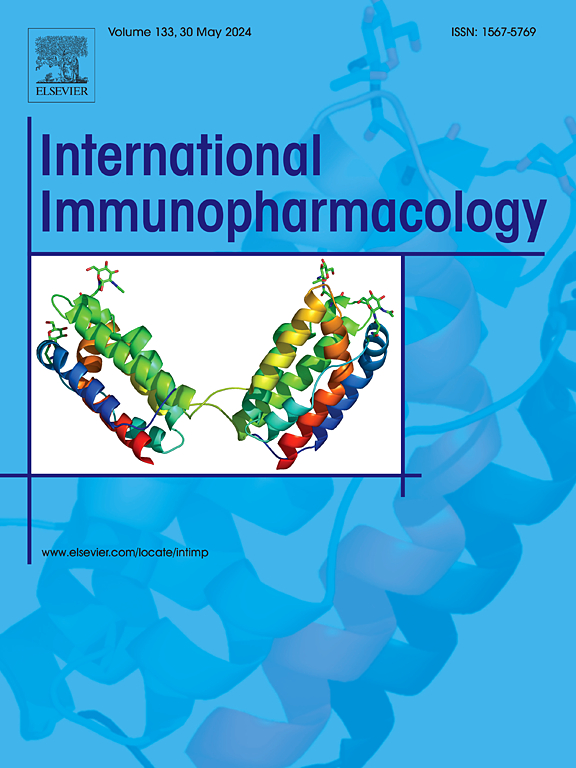BC-1通过调节IgD和B细胞BCR-NF-κB信号通路改善胶原诱导的小鼠关节炎
IF 4.7
2区 医学
Q2 IMMUNOLOGY
引用次数: 0
摘要
类风湿性关节炎(RA)是一种缺乏有效治疗药物的自身免疫性疾病。山毛榉。广泛分布于中国西南部和西北部。它的根茎被用作治疗风湿性关节炎、痢疾、感冒、喉咙痛和头痛的中药。(20S*, 24R*)-环氧-9,19-环烷烷-3β,12β,16β,25-四醇-3- o -β- d -木吡喃苷(BC-1)是从山毛榉中分离得到的重要抗炎皂素。然而,BC-1的特异性抗ra机制尚未完全阐明。本研究采用胶原蛋白建立DBA1小鼠RA模型,用CyTOF法分析小鼠脾脏免疫细胞。结果,BC-1显著缓解CIA小鼠关节炎严重程度,降低AI评分,但对体重无显著影响。BC-1还能减轻CIA小鼠炎症、破骨细胞形成、软骨损伤、踝关节骨损伤,降低血清TNF-α、IL-1β、IL-6、PGE2、COX-2水平。根据CyTOF测定,CIA小鼠B细胞/免疫细胞比值和B细胞IgD水平明显升高,BC-1可缓解这一现象。此外,BC-1显著抑制B细胞BCR-NF-κB信号通路的激活。这些发现提示BC-1通过抑制IgD和BCR-NF-κB信号通路具有治疗RA的潜力。本文章由计算机程序翻译,如有差异,请以英文原文为准。

BC-1 improves collagen-induced arthritis in mice by modulating IgD and BCR-NF-κB signalling pathway of B cells
Rheumatoid arthritis (RA) is an autoimmune disease lacking effective treatment drugs. Beesia calthaefolia Ulbr. widely distributes in the southwest and northwest of China. Its rhizomes are used as traditional Chinese medicine (TCM) for the treatment of rheumatoid arthritis, dysentery, colds, sore throats, and headaches. (20S*, 24R*)-epoxy-9,19-cyclolanostane-3β,12β,16β,25-tetraol-3-O-β-D-xylopyranoside (BC-1) was a key anti-inflammatory saponin isolated from Beesia calthaefolia. However, the specific anti-RA mechanism of BC-1 has not yet been fully elucidated. In this study, an RA model was established by collagen in DBA1 mice, the immune cells in spleen of mice were analyzed using CyTOF. As a result, BC-1 significantly relieved arthritis severity and decreased the AI score of CIA mice with no significant impact on bodyweight. Additionally, BC-1 can also reduce inflammatory, osteoclast formation, cartilage damage, and bone damage in ankle joint, decreased the serum levels of TNF-α, IL-1β, IL-6, PGE2 and COX-2 of CIA mice. According to the CyTOF assay, the ratio of B cells/immune cells and IgD levels in B cell markedly increased in CIA mice, which were relieved by BC-1. Furthermore, BC-1 significantly inhibited the activation of BCR-NF-κB signalling pathway of B cells. These findings suggested that BC-1 has the potential for RA treatment by inhibiting IgD and BCR-NF-κB signalling pathway.
求助全文
通过发布文献求助,成功后即可免费获取论文全文。
去求助
来源期刊
CiteScore
8.40
自引率
3.60%
发文量
935
审稿时长
53 days
期刊介绍:
International Immunopharmacology is the primary vehicle for the publication of original research papers pertinent to the overlapping areas of immunology, pharmacology, cytokine biology, immunotherapy, immunopathology and immunotoxicology. Review articles that encompass these subjects are also welcome.
The subject material appropriate for submission includes:
• Clinical studies employing immunotherapy of any type including the use of: bacterial and chemical agents; thymic hormones, interferon, lymphokines, etc., in transplantation and diseases such as cancer, immunodeficiency, chronic infection and allergic, inflammatory or autoimmune disorders.
• Studies on the mechanisms of action of these agents for specific parameters of immune competence as well as the overall clinical state.
• Pre-clinical animal studies and in vitro studies on mechanisms of action with immunopotentiators, immunomodulators, immunoadjuvants and other pharmacological agents active on cells participating in immune or allergic responses.
• Pharmacological compounds, microbial products and toxicological agents that affect the lymphoid system, and their mechanisms of action.
• Agents that activate genes or modify transcription and translation within the immune response.
• Substances activated, generated, or released through immunologic or related pathways that are pharmacologically active.
• Production, function and regulation of cytokines and their receptors.
• Classical pharmacological studies on the effects of chemokines and bioactive factors released during immunological reactions.

 求助内容:
求助内容: 应助结果提醒方式:
应助结果提醒方式:


